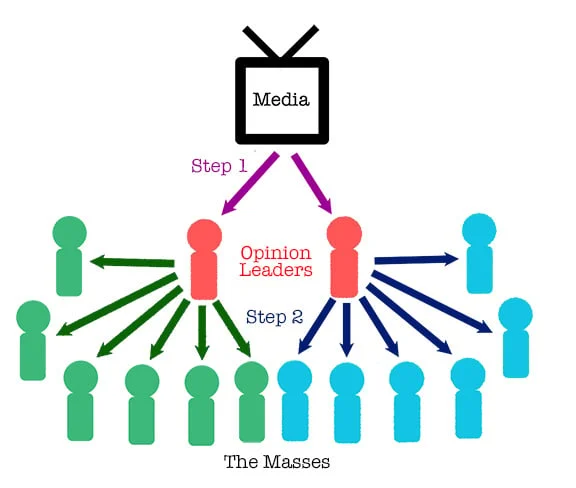
The Two-Step Flow Theory of communication, introduced by Paul Lazarsfeld, Bernard Berelson, and Hazel Gaudet in their 1944 book The People’s Choice, suggests that media is disseminated to and influences the public through a distinct process. First, the media is disseminated to opinion leaders, individuals who simply pay more attention to the media and are often socially connected, who interpret that media for themselves. Opinion leaders then communicate their interpretations to the public at large. The theory argues that people are more influenced by the opinions and interpretations of these leaders than by the media itself. Consequently, the public’s understanding of media is filtered through these intermediaries, whose personal biases and viewpoints shape how the information is conveyed and perceived. This process not only applies to highly traditional forms of media as examined by the authors in 1944, but also to modern days iterations of media like social platforms and highly marketed brands.┬á
The Two-Step Flow Theory of Communication, introduced by Paul Lazarsfeld, Bernard Berelson, and Hazel Gaudet in the 1944 book The People’s Choice, analyses the pattern media dissemination follows. First, the media is disseminated to opinion leaders, socially connected individuals who pay more critical attention to the media and interpret that media for themselves. Opinion leaders then communicate their interpretations to the public at large. Consequently, the public’s understanding of media is filtered through these intermediaries, whose personal biases and viewpoints shape how the information is conveyed and perceived. This process not only applies to highly traditional forms of media as examined by the authors in 1944, but also to modern-day iterations of media like social platforms and highly marketed brands.
Building on this, the two-step flow theory suggests that opinion leaders, such as social media influencers (SMIs), serve as direct channels between brands and consumers. These opinion leaders can shape consumers’ attitudes and behaviours through the information they share, amplifying the impact of their communication and enhancing the influence of brands on their audiences. This blog post will focus on social media influencersÔÇÖ role as prominent opinion leaders, exploring how their trustworthiness and authenticity affect the success and perception of sponsored brands, which these influencers market, in the marketplace.

SMIs have to be considered trustworthy for their opinions, and the attached marketing of those opinions, to hold any merit in the eyes of the public. Trustworthiness here refers to the degree to which SMIs are perceived as credible, reliable, and honest sources of information by their audience. In other words, how likely a member of the public is to trust a particular influencer to recommend good products, rather than simply any, or bad, products. When an influencer is seen as trustworthy, their audience is more likely to believe in the authenticity of their endorsements, perceiving their recommendations as genuine rather than driven solely by financial gain. This has impacts on both the brand and the influencer.
A 2024 study by Rathjens et al. investigates the influence of brand equity and recommendation types on consumer attitudes and visit intentions. The study shows that when SMIs endorse high-equity brands, brands that consumers already believe to be good, explicit recommendations tend to generate more positive attitudes toward both the influencer and the brand, while implicit endorsements can cause ambiguity. However, explicit endorsements of low-equity brands, brands consumers already view negatively, can backfire, decreasing trust in the influencer and further eroding trust in the brand. Further, influencers that constantly endorse high-equity brands are more likely to be trusted and believed when they endorse a low-equity brand. This increases trust, and generates purchases, for the low-equity brand. However, influencers that constantly endorse low-equity brands are still untrustworthy even when endorsing a high-equity brand. This erodes trust in the high-equity brand which over time can negatively impact the likelihood of a consumer purchase.┬á In other words ÔÇťperceived effort and authenticityÔÇŁ of an influencer impacts a consumer’s ÔÇťtrust and willingness to act on recommendationsÔÇŁ from said influencer (Ali, 2024).┬á
Through the lens of SMIs, one can see how the trustworthiness or untrustworthiness of an opinion leader plays a critical role within the two-step theory. Trustworthy leaders are likely to have their opinions on media believed and accepted by the public. Untrustworthy leaders are likely to not be believed at best, or lead the public to believe the opposite of their interpretations at worst. This plays a critical role for brands looking to turn to opinion leaders, specifically SMIs, as a critical part of their marketing.
References
Ali, A. (2024). Instagram Influencers for Online Purchase Information. Sein├Ąjoki University of Applied Sciences.
Katz, E. (1957). The Two-Step Flow of Communication: An Up-To-Date Report on an Hypothesis. The Public Opinion Quarterly, 21(1), 61ÔÇô78.
Rathjens, B., Wu, A., Zhang, L., & Wei, W. (2024). When Social Media Influencer Endorsement Backfires: Unpacking Fallout From Explicit Endorsements Across Brand Equity Levels. Journal of Hospitality & Tourism Research, 48(8), 1467-1480


Hi Jude!
This blog does an excellent job of connecting the Two-Step Flow Theory to the modern-day phenomenon of social media influencers (SMIs). The explanation of opinion leaders as intermediaries between media and the public is clear and well-articulated, making it easy to see how influencers fit into this framework. The discussion of trustworthiness and its impact on brand perception is particularly insightful, especially with the study by Rathjens et al. highlighting the nuanced relationship between influencer endorsements and brand equity. The distinction between high-equity and low-equity brands and how they affect the influencerÔÇÖs credibility is fascinating. ItÔÇÖs a reminder that authenticity and consistency are key for influencers who want to maintain their audienceÔÇÖs trust. The blog could delve a bit more into examples of influencers who have successfully navigated this balanceÔÇöor failed toÔÇöadding practical context to the theory. Overall, this is a thoughtful exploration of how traditional communication theories like the Two-Step Flow remain relevant in the digital age. Great work!